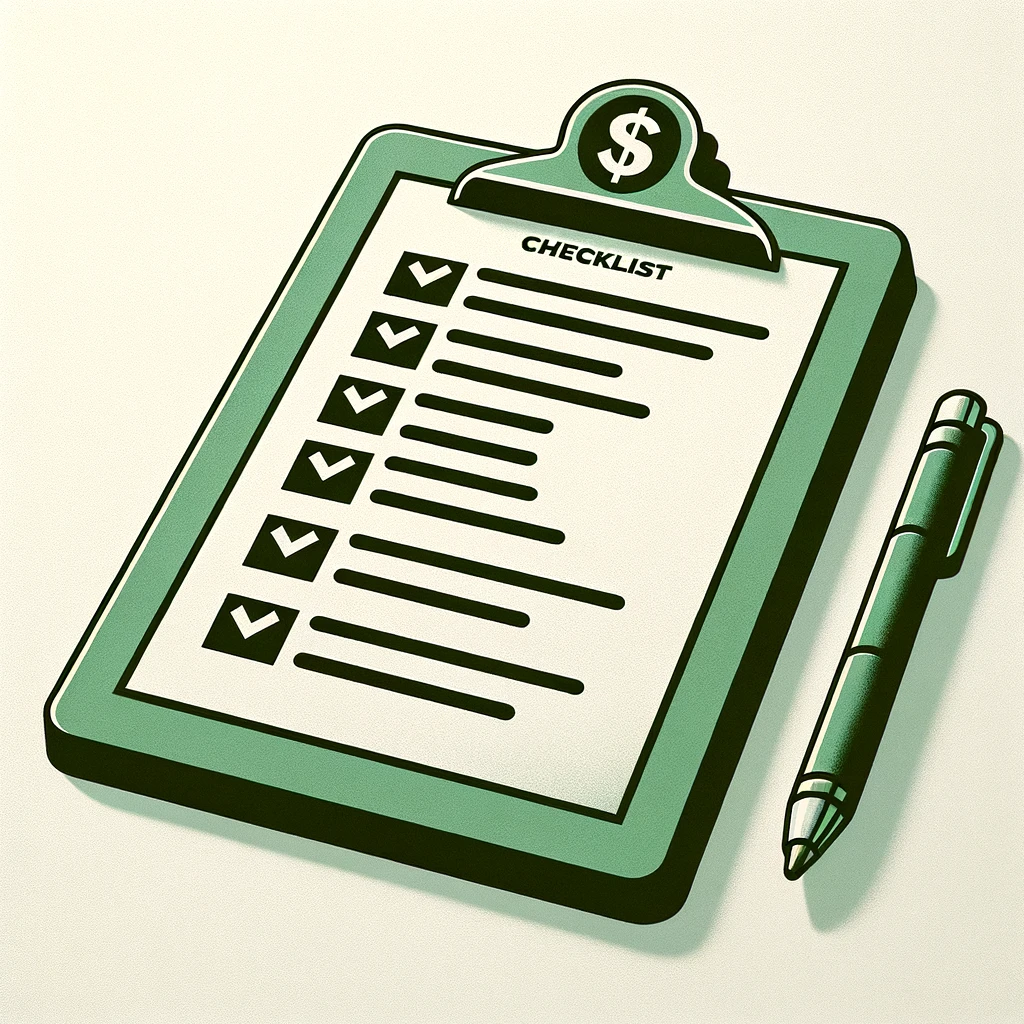Introduction
A budget list acts as a financial beacon, guiding my spending decisions and ensuring that I align my outflows with my priorities and goals. It’s essential for tracking where every dollar goes, helping me avoid debt and save for the future, turning financial chaos into structured progress. It also acts as my personal financial compass, providing clear direction on expenditure and saving, ensuring that every financial decision is a step towards my goals. It’s my strategic plan that translates my income and expenses into a visual guide and helps me navigate through the complexities of personal finance, avoiding unnecessary detours and keeping me on the path to success.
Creating a Budget List
Step-by-step guide on how to make a budget list
Creating a budget list from scratch has been a transformative process for me, a path that led to financial awareness and control. Here’s how I did it:
Step 1: Assess Your Total Income
The first step I took was to calculate my total monthly income. I included every source: my main job, any side gigs, and passive income streams. It’s crucial to have a clear understanding of what you’re working with financially.
Step 2: List Your Fixed Expenses
Next, I listed out all my fixed expenses — those bills that don’t change much from month to month, such as rent, utilities, insurance, and debt repayments. Knowing these non-negotiables gave me a baseline for my mandatory spending.
Step 3: Track Your Variable Expenses
Then, I tracked my variable expenses — these are the costs that can fluctuate, like groceries, dining out, and entertainment. For a full month, I kept every receipt and recorded all purchases to understand my spending habits accurately.
Step 4: Set Financial Goals
After understanding my income and expenses, I set clear, achievable financial goals. Whether it was saving for an emergency fund, a vacation, or retirement, these goals helped me determine how to allocate my funds effectively.
Step 5: Create Spending Categories
With my goals in mind, I categorized my expenses into ‘needs’ and ‘wants’ to prioritize my spending. This helped me make more intentional choices about where my money was going.
Step 6: Allocate Funds to Each Category
I then allocated a specific amount of money to each category, ensuring that my needs were covered, my financial goals were being met, and I still had some room for wants.
Step 7: Adjust as Necessary
After the first month, I reviewed my budget list and made adjustments. Maybe I underestimated my grocery budget or overestimated my leisure spending. Adjusting my budget list allowed it to evolve with my lifestyle and financial situation.
Step 8: Monitor and Update Regularly
I regularly revisit my budget list, especially when my financial situation changes. This could mean a pay raise, a new recurring bill, or a change in financial goals. Keeping my budget list up to date is crucial for it to remain a useful tool.
By following these steps, I created a living budget list that not only reflects my current financial situation but also guides my financial decisions and helps me work towards my future financial success.
Utilizing templates and technology to create a budget list in Excel
Utilizing Excel templates and technology to create a budget list can streamline the process and enhance accuracy. Here’s how to do it effectively:
Choose a Template: Start by selecting a premade budget template in Excel. Microsoft offers a variety of budget templates that you can choose from within Excel or download from their website. These templates have predefined categories and formulas that can save time.
Customize Your Template: Once you’ve chosen a template, customize it to fit your specific financial situation. You can add or remove categories, adjust formulas, and change the layout to make it more intuitive for you.
Input Your Data: Begin entering your income and expenses into the template. Use the data you’ve gathered from your financial documents. Be sure to categorize each expense correctly so that Excel can accurately track and report your financial activity.
Use Formulas: Take advantage of Excel’s powerful formulas to automate calculations. For example, use the SUM formula to total your monthly expenses, or use the MINUS formula to subtract your expenses from your income to calculate your monthly surplus or deficit.
Create Graphs and Charts: Excel allows you to create visual representations of your data. Use pie charts to illustrate how your expenses break down into categories, or line graphs to track your spending or savings over time.
Set Up Conditional Formatting: Excel’s conditional formatting can highlight areas of concern, like expenses that exceed your budget. Set up rules to change the color of a cell when you approach or exceed your budget limit.
Automate Recurring Entries: For fixed expenses that don’t change from month to month, you can automate these entries so that they populate the spreadsheet each new period, saving you the need to enter them manually.
Integrate with Other Tools: If you use online banking or budgeting apps, you might be able to export data to Excel. Some apps offer direct integration with Excel, further automating your budget tracking.
Regular Update: Once your budget is set up, it will require regular updating. Set aside time each week or month to update your spreadsheet with the latest income and expenses
Use Macros for Advanced Automation: If you’re comfortable with more advanced Excel features, you can create macros to automate repetitive tasks, like sorting expenses, updating date ranges, or preparing reports for review.
By leveraging Excel templates and these technology features, you can create a detailed and dynamic budget list that will help you monitor your financial health and reach your financial goals.
Understanding the Essentials of a Budget List
What is a budget list and its critical role in managing finances
A budget list, in my experience, is a comprehensive outline of anticipated income and planned expenses. It’s a tool I rely on to forecast monthly cash flow, track spending, and save diligently. This list serves as a financial compass, guiding my decisions and preventing fiscal drift. By comparing projected costs against actual spending, I can pinpoint discrepancies and adjust habits accordingly. It’s not just about keeping tabs on my money; it’s about ensuring every dollar works towards my larger financial aspirations.
The fundamental items to include in a budget list
In my budget list, I always include fixed expenses like rent and utilities, which are non-negotiable and consistent. Variable expenses, such as groceries and entertainment, are also key, as they fluctuate and offer room for adjustment. I’m careful to track periodic expenses, those that arise quarterly or annually, setting aside a portion each month to avoid surprises. Lastly, I prioritize savings, earmarking funds for emergency reserves, investments, and personal goals. This four-category framework forms the backbone of my budgeting strategy, balancing the immediate with the future, ensuring every aspect of my financial life is accounted for.
Refining a Budget List
Identifying what should not be listed in a budget to maintain focus
In my approach to budgeting, I’ve learned that clarity is key, which means knowing what not to include is as important as knowing what to include. I steer clear of listing irregular, non-essential expenses that can cloud my financial picture—like a rare splurge on a luxury item. Instead, I focus on recurring and planned expenses that reflect my regular spending habits. I also avoid vague categories that could hide multiple expenses, preferring to break them down for precision. This disciplined approach keeps my budget list concise, actionable, and aligned with my financial goals, allowing me to track my progress with accuracy.
Some items that I deliberately avoid including in my budget are:
One-Time Splurges: Rare indulgences, such as an expensive piece of jewelry or a spontaneous weekend getaway, don’t find a place in my regular budget since they can disrupt the consistency of my financial planning.
Immaterial Gifts and Donations: While generosity is important, I track gifts and donations separately unless they are a fixed, recurring item, to prevent skewing my monthly expenditure analysis.
Daily Incidentals: The minutiae of daily life, like a cup of coffee bought on a whim, are not individually listed. Instead, I allocate a small, general fund for miscellaneous expenses to cover these.
Work Expenses Reimbursed: Costs that are covered by my employer, such as business travel or client entertainment, are not part of my budget since they don’t impact my personal finances.
Investment Fluctuations: The day-to-day or month-to-month changes in investment values don’t go into my budget because they aren’t actualized gains or losses until I sell the investment.
By excluding these, I maintain a focused and realistic view of my regular spending and saving patterns.
How to differentiate between wants and needs in your budget list
Differentiating between wants and needs is fundamental to my budgeting process. I consider ‘needs’ as the essentials required for survival and basic comfort—things like rent, utilities, groceries, and necessary transportation. These are non-negotiables that I prioritize in my budget.
On the other hand, ‘wants’ are the extras that enhance life’s quality but are not vital. For me, a ‘want’ might include dining out, a subscription service, or a weekend trip. These are flexible and often the first areas I trim if I need to tighten my budget.
To draw a clear line between the two, I ask myself a few questions: “Can I live without this?” “Is this a recurring expense for something I regularly use, or is it a luxury?” If I’m unsure, I consider the long-term value it adds to my life. If it’s more about immediate gratification than sustained benefit, it’s likely a ‘want’.
I also review my spending habits over time. If I notice I’m consistently overspending in my ‘wants’ category, I reevaluate my choices to ensure they’re truly contributing to my happiness and not just impulsive purchases. This self-reflection is crucial for maintaining a budget that aligns with my financial goals and personal values.
Budget List Considerations
Key factors to consider for a comprehensive budget list
When I create a comprehensive budget list, I factor in several key elements to ensure it’s both thorough and effective. Firstly, I consider all sources of income, not just my primary paycheck but any side hustles or passive income streams as well. I include fixed expenses like rent, utilities, insurance, and car payments, which are predictable and mandatory each month.
Next, I account for variable expenses—those that fluctuate—like groceries, gas, and leisure activities. I always include a savings category, aiming to set aside a portion for emergencies, retirement, and personal goals. Debt repayment is crucial, too, as I prioritize reducing any outstanding debts.
I don’t overlook periodic expenses such as annual subscriptions or bi-annual insurance premiums, pro-rating them to ensure they’re accounted for monthly. And finally, I reserve a small percentage for miscellaneous or unexpected costs to avoid being caught off guard. This holistic approach gives me a realistic view of my financial situation and helps me plan for the future while living comfortably in the present.
Tailoring a budget list to reflect financial goals and lifestyle
To tailor my budget list to align with my financial goals and lifestyle, I start by defining what I’m working towards—be it paying off debt, saving for a home, or planning for retirement. I allocate specific portions of my income to these goals, ensuring they’re not just aspirations but actionable items within my budget.
I then adjust my spending categories to mirror my lifestyle choices. For instance, if fitness is a priority, I include a gym membership or equipment costs. Similarly, if I’m a food enthusiast, I might allocate more to my grocery budget for premium ingredients but cut back on other less important areas.
Importantly, I track my spending and regularly review my budget against my actual habits, tweaking it to better fit my life as it evolves. This keeps my financial plan as dynamic as I am, ensuring it’s a true reflection of both my current reality and future aspirations.
Practical Application and Example
A closer look at a budget list example and its application
Monthly Income:
- Salary: $3,000
- Freelance Work: $500
Fixed Expenses:
- Rent: $1,200
- Utilities (electricity, water, internet): $200
- Insurance (health, car): $300
- Debt Repayment (student loan): $200
Variable Expenses:
- Groceries: $300
- Gas/Transportation: $100
- Dining Out: $150
- Entertainment: $100
- Gym Membership: $50
Savings and Investments:
- Emergency Fund: $200
- Retirement Savings (IRA): $150
- Vacation Fund: $50
Total Expenses:
- Total Fixed Expenses: $1,900
- Total Variable Expenses: $700
- Total Savings: $400
Budget Review:
- Total Income: $3,500
- Total Expenses: $3,000
- Remaining: $500
In this application, I earn a total of $3,500 monthly and have budgeted for both necessities and a few wants, prioritizing a balanced lifestyle. After accounting for all my expenses, I have $500 remaining. Instead of spending this surplus impulsively, I might decide to divide it between an extra payment towards my debt to accelerate its payoff and boost my vacation fund, reflecting my goal to be debt-free and value experiences over possessions.
Each month, I review this budget, comparing projected costs with actual spending using an app or spreadsheet. If I spend less on groceries one month, I can choose to roll over the savings or reallocate it to a different category that may need more funding the next month. This living document is adjusted based on changes in income, life circumstances, or financial priorities, ensuring it always serves my current needs and future goals.
Insights from various budget list items and their impact on overall finances
In reviewing the budget list I provided, each category holds specific insights and importance for my overall financial health. Starting with the fixed expenses, items like rent, utilities, and insurance are non-negotiable for maintaining a basic standard of living. They consume a significant portion of my income, emphasizing the importance of housing and utility choices in my financial planning.
Variable expenses, such as groceries, dining out, and entertainment, offer more flexibility. I’ve learned that careful management here can lead to significant savings without sacrificing quality of life. For instance, by cooking more at home and limiting dining out, I’ve managed to enjoy healthier meals while freeing up funds for other priorities.
Savings and investments are the backbone of my future financial security. Allocating funds to an emergency fund, retirement, and specific goals like vacations, instills a sense of discipline and foresight in my financial behavior. It’s here that I see the direct impact of today’s choices on tomorrow’s possibilities.
The remaining balance, in this case, $500, represents an opportunity. It’s a testament to the effectiveness of my budgeting strategy, allowing me room to adjust, invest further, or even indulge occasionally without derailing my financial goals.
Overall, each item on my budget list serves as a piece of a larger financial puzzle. By understanding the role and impact of each, I navigate my finances with intention, ensuring that every dollar spent or saved is a step toward achieving a balanced and fulfilling financial life.
Regular Review and Updates
The importance of regular reviews and updates on a budget list
The importance of regular reviews and updates to my budget list cannot be overstated. This practice ensures that my budget remains aligned with my current financial situation, goals, and lifestyle changes. Over time, I’ve noticed that expenses can fluctuate, income can vary, and financial objectives can evolve. By reviewing my budget list monthly, I can adjust for unexpected expenses, recognize and correct any overspending patterns, and reallocate funds to better serve my priorities.
Moreover, this ongoing process allows me to stay proactive about my financial health. If a new expense arises or if I achieve a financial goal, updating my budget ensures that my financial plan reflects these changes. It also keeps me motivated and accountable, as seeing progress towards my goals encourages me to maintain good financial habits.
In essence, regular reviews and updates are crucial for keeping my budget relevant and effective, acting as a dynamic tool that guides my financial decisions and helps me adapt to life’s uncertainties with confidence.
Strategies for keeping your budget list aligned with changing financial circumstances
Monthly Reviews: I make it a habit to sit down at the end of each month to review my budget list against my actual spending and income. This helps me identify any deviations and understand their causes, whether they are one-off anomalies or signs of changing trends.
Adjusting for Income Changes: Whenever there’s a change in my income, whether it’s an increase due to a new job, a bonus, or a decrease perhaps due to reduced work hours, I adjust my budget accordingly. I allocate extra income towards savings or debt repayment, and in case of a decrease, I identify areas where I can cut back without significantly impacting my quality of life.
Emergency Fund Focus: Recognizing the importance of an emergency fund, I prioritize maintaining and building this safety net. It acts as a buffer that allows me to adjust my budget for unexpected expenses without derailing my financial goals.
Flexible Spending Categories: I keep certain budget categories flexible, such as entertainment or dining out, so I can easily adjust them based on current financial priorities without impacting essential expenses like rent or utilities.
Goal Reassessment: As my financial circumstances change, I reassess my short-term and long-term financial goals. This might mean adjusting timelines, setting new goals, or reallocating funds to ensure that my budget continues to reflect my current priorities and aspirations.
Utilizing Financial Tools: I leverage budgeting apps and financial software to track my spending and income in real-time. These tools offer insights and alerts that help me stay on top of my finances and quickly adjust my budget as needed.
By applying these strategies, I ensure that my budget remains a living document, one that evolves with me and my financial landscape, keeping me on a path toward financial well-being and goal achievement.
Conclusion
Throughout my journey, I’ve learned that creating and maintaining an effective budget list is both an art and a science. It starts with a clear understanding of my income, followed by a detailed breakdown of my expenses, both fixed and variable, and a commitment to savings and investment goals. This process has not only helped me manage my finances more effectively but also instilled a sense of financial discipline in my daily life. By treating my budget list as a dynamic tool that evolves with my financial circumstances, I’ve been able to stay aligned with my financial goals, adapt to unexpected changes, and make informed decisions that enhance my financial wellbeing. I encourage everyone to embrace this approach, recognizing that a well-maintained budget list is not just about numbers; it’s a roadmap to financial security and peace of mind.



